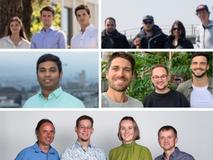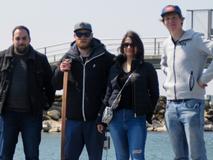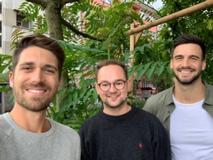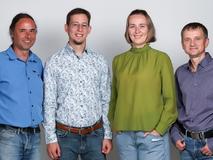Startups developing a digital therapy service, a sailboat hull cleaning service, greener lithium-ion cells, an AI-based platform for building owners, and a non-invasive continuous glucose monitoring bracelet each win CHF 10,000
20.08.2021
Akina, CleanBoat, GreenBattRe, greenovate, and HoraceHealth win Venture Kick's first stage of financial and entrepreneurial support. Their projects connect the worlds of digital healthcare and entertainment, allow sailboat owners to clean their hull while remaining on deck without taking the boat out of the water or moving it, enable greener and cheaper ways to manufacture lithium-ion batteries that can be recycled, implement and finance energy renovation in a few simple steps, and help people that have diabetes to monitor their glucose levels.
 |
 Akina Team: (from left to right) Intern Giulia Amos and Co-Founders Florian Haufe and Michele Xiloyannis
|
 CleanBoat: (from left to right) Co-Founder and CEO Alexandre Braissant, Co-Founder and CTO Nico Luginbühl, Co-Founder and COO Aleksandra Samardzieva, and CPR Laurent Forrer
|
 GreenBattRe CEO Ramesh Shunmugasundaram
|
 greenovate: (from left to right) Dominik Bucher, Jakub Szczesniak, and Diego Sigrist
|
 Horace Team: (from left to right): Boris Conforty, Benjamin Rienacker, CEO and Co-Founder Tatiana Eliseeva, Co-Founder Vadim Kimlaychuk
|
Akina: connecting the worlds of digital healthcare and entertainment
There are over 700k patients in musculoskeletal rehabilitation clinics each year, in the DACH countries alone. They all typically go through a 4-week inpatient therapy program, followed by 12 weeks of outpatient rehabilitation and home-based therapy. Over 70% of them, however, do not adhere to the home-based therapy program, with tragic consequences for their health and well-being. There is compelling evidence that this happens because training is simply too boring: patients are not motivated by the way physical therapy programs are currently prescribed.
The Akina team is currently made of Co-founders Dr. Florian Haufe and Dr. Michele Xiloyannis, and Giulia Amos, an intern and master student in Health Science and Technology at ETH Zurich. They are hosted by the SMS Lab at ETH Zurich. Both Co-founders hold a Ph.D. in Healthcare Robotics and have extensive experience in AI, physical therapy, and human motion analysis. Akina relies on the scientific advice of Prof. Robert Riener, support from the Swiss Center for Clinical Movement Analysis, and a collaboration with the ETH Center for Rehabilitation Engineering and Science. They are located at the Balgrist Campus, a cross-disciplinary research facility with an emphasis on connecting engineers and medical professionals. The team offers a digital therapy service that allows individuals to perform physical therapy at home, for example after completing an in-patient stay at a rehabilitation clinic. Their service will combine interactive environments, AI-based assistance, motion detection, and telerehabilitation in an unprecedented way. Users of their service will experience the fascinating world of state-of-the-art interactive environments while engaging in personalized, evidence-based, and data-driven therapy programs. At its core, Akina offers an adaptive software that allows its users to play the latest commercial videogames while completing a personalized set of clinical physiotherapy exercises. This is achieved by mapping exercises, detected by a simple wearable camera, to gameplay actions. For example, moving a leg could score the decisive goal in FIFA 2021 Champions League, or raising the arm could make a virtual Roger Federer serve an ace.
They plan to use the Venture Kick Stage 1 funds for legal counsel on incorporation, advancing trademark protection to the US market, and demo roadshow.
CleanBoat: Sailboat hull cleaning service
Currently, in order to maintain the hull of their yachts, private individuals will generally install an antifouling. This technique uses toxic products, including copper, zinc, and other substances that are harmful to wildlife and biodiversity. The impact is immense: 1 m2 of paint can pollute 150,000 m3 of water. Moreover, the installation of this antifouling requires the intervention of a shipyard, which obliges sailboat owners to regularly use their expensive services (approx. CHF 2000 every 3 years).
The co-founders of CleanBoat as part of the main BeX option of the HES-SO Valais currently consists of a HES-SO Valais industrial systems engineer, a HES-SO Valais economist, an EHL economist, and a HEIG-VD economist who is currently doing the Master Innokick. They offer a tool that allows sailboat owners to clean their hull while remaining on deck without taking the boat out of the water or moving it. It is a motorized brush connected to a handle with which it is possible to clean the entire hull in only 30 minutes. Thanks to this system, the sailboat maintains its performance throughout the season thanks to regular cleaning. Currently, in order to maintain the hull of their boat, individuals will generally proceed to the installation of an antifouling. Approximately 300’000 liters are applied each year in Switzerland and the toxic components in it are eroding into the lakes. Their product offers an alternative to this expensive and environmentally harmful method. The next steps in their strategic operations will involve strengthening their presence in the French-speaking part of Switzerland (approx. 15'000 sailing boat owners) and extending their business on the major Swiss lakes. Their objective is to have conquered the Swiss market by 2026 (approx. 30'000 sailing boat owners).
The Venture Kick funds will be used to meet the demand for services, redesign communication and promotion tools, apply for a Swiss patent, create the company, cover the legal aspect and pay salaries.
GreenBattRe: greener lithium-ion cells at a significantly reduced cost
Lithium-ion batteries have enabled the widespread adoption of portable electronics and electric vehicles. The automotive sector will represent its largest market in Europe. However, the lack of domestic lithium-ion battery manufacturing in Europe forces the European OEMs to rely on Asian companies, which have a cost advantage. Nonetheless, Europe can prosper by focusing on factors such as enhanced sustainability, productivity, quality, safety, and recyclability. Leveraging integrated technology innovations in battery materials processing, production and recycling can strengthen European Lithium-ion battery manufacturing competitiveness. GreenBattRe intends to manufacture cheaper lithium-ion cells with the least carbon footprint in Europe.
GreenBattRe's team is comprised of Dr. Ramesh Shunmugasundaram, a senior researcher at the Materials and Device Engineering group from ETH Zurich, and its scientific advisor Prof. Dr. Vanessa Wood, who is currently serving as Vice President of Knowledge Transfer and Corporate Relations at ETH Zurich. GreeBattRe has proprietary battery electrode manufacturing technology – novel battery materials processing and production technology integrated with materials recycling. Our technology eliminates toxic processing solvents, reduces manufacturing steps, and enables battery materials recycling. Our start-up can produce greener lithium-ion cells at a significantly reduced cost. Our goal of cell manufacturing in Europe is in line with Europe's effort to become competitive in lithium-ion battery manufacturing.
The Venture Kick Funds will be used for prototype validation and visits to potential customers and partners.
greenovate: AI-based platform for building owners
Buildings account for almost 40% of global CO2 emissions. To avoid a climate disaster, we need to renovate the building stock to reach net zero. However, the rate of energy renovation is exceptionally low – only around 1% of all Swiss buildings are renovated each year. The major barriers for building owners preventing energy renovation are the following. First, a lack of awareness and expertise on the feasibility and profitability of renovation strategies. Second, high investment costs are required for sustainable building solutions, even though they are often cheaper in the long run. Finally, complex, costly, and time-consuming data collection, and renovation planning processes. These key barriers result in a huge untapped environmental, social and financial potential of the building stock.
greenovate's co-founders are Diego Sigrist, a recent graduate of MSc. Energy Science and Technology (MEST) at ETH and Jakub Szczesniak, a graduate-to-be of MEST at ETH and Building Technology program at MIT, and Angel Investor Dominik Bucher. Advisors are from academia (MIT), banks, and energy companies. greenovate is a technology-powered platform that provides comprehensive solutions for building owners to plan, implement and finance energy renovation in a few simple steps. Due to our AI-driven algorithms, an automatic building appraisal and energy renovation optimization is performed, which informs building owners about site-specific technical and legal feasibility of renovation measures and designs the cost-optimal renovation strategy for the building to become carbon neutral. With greenovate, the entire renovation process is streamlined and all offerings are provided transparently and conveniently to ensure not only decarbonization of the building stock but also that building owners save money as a result. Every year, 88’000 heating systems are replaced in Swiss residential buildings, corresponding to a volume of approx. CHF 2.6 billion. Studies suggest that almost all building owners prefer to install a sustainable, low-carbon heating system but still more than half (51% or 45’000) choose a fossil fuel solution - because of an information barrier or the high investment costs. Therefore, there are 45’000 building owners in need of personalized consulting and/or financing, per year. With a CHF 300 fee for a financing solution and a 1% (of loan size) fee for banks, the total Swiss market for greenovate's service is worth CHF 36 million. They aim for a market share of 10% - annual revenue of CHF 3.6 million. Since their solutions are scalable, they also want to join the European market worth CHF 3 billion a year.
The Venture Kick funds will be used to develop a go-to-market strategy by end of November, define the company formalities by mid-December, and found the company by end of March 2021. Financial support in the first Venture Kick phase is crucial and mainly needed for securing access to data repositories and software programs, computing power, web development and design, host server, and marketing.
HoraceHealth: Non-invasive wearable continuous glucose monitoring system
Every eleventh person on Earth has either diabetes or is at the risk of developing it. This means also the glucose measurement is essential for every eleventh person. Unfortunately, all current products on the market for measurement of the glucose level work with physical skin intervention, and therefore are painful and/or physically uncomfortable. Plus, they require consumables, producing waste and being expensive in the long term.
HoraceHealth's co-founders are Vadim Kimlaychuk, the project initiator, who is working on the hardware part and who also has diabetes type I himself, and Tatiana Eliseeva, she works on the data analysis workflow and she is currently the CEO of the company, both on the right side of the picture. Lately, the project joined Boris Conforty, the first from the left side, who develops embedded software, and Benjamin Rienacker, also working on the experiment design and data analysis. Aside from their current roles in HoraceHealth, their assets belong also to such skills and experiences as MedTech R&D, entrepreneurship, optical physics. All together they are currently finalizing the second model with an additional impedance channel and simplified interface, and they also intend to develop an accompanying data management infrastructure for it. HoraceHealth's product can also be used for the collection of medical statistics and it looks like a fitness bracelet. There are currently several players on the market of continuous glucose monitoring based on flash monitoring/implant systems, but they all are invasive. Other non-invasive glucose monitoring systems that are currently under development, although being FDA approved or on the stage of clinical trials, are also not yet available for the customer to purchase. HoraceHealth stands ahead of its competitors because of several parallel detection channels and a unique signal analysis, which increases signal reliability and can deal with artifacts. Their existing prototype has shown its efficiency for detecting glucose levels for hundreds of measurements in continuous acquisition modality, some of which were cross-checked with spot-checked blood samples.
They plan to spend the Venture Kick Stage 1 funds on the second prototype which allows collecting data from persons without the team supervision. Their main milestone on this stage is to collect min.150 additional samples of duration 6 to 24 hours from at least 30 people, including the diabetes patients.
There are over 700k patients in musculoskeletal rehabilitation clinics each year, in the DACH countries alone. They all typically go through a 4-week inpatient therapy program, followed by 12 weeks of outpatient rehabilitation and home-based therapy. Over 70% of them, however, do not adhere to the home-based therapy program, with tragic consequences for their health and well-being. There is compelling evidence that this happens because training is simply too boring: patients are not motivated by the way physical therapy programs are currently prescribed.
The Akina team is currently made of Co-founders Dr. Florian Haufe and Dr. Michele Xiloyannis, and Giulia Amos, an intern and master student in Health Science and Technology at ETH Zurich. They are hosted by the SMS Lab at ETH Zurich. Both Co-founders hold a Ph.D. in Healthcare Robotics and have extensive experience in AI, physical therapy, and human motion analysis. Akina relies on the scientific advice of Prof. Robert Riener, support from the Swiss Center for Clinical Movement Analysis, and a collaboration with the ETH Center for Rehabilitation Engineering and Science. They are located at the Balgrist Campus, a cross-disciplinary research facility with an emphasis on connecting engineers and medical professionals. The team offers a digital therapy service that allows individuals to perform physical therapy at home, for example after completing an in-patient stay at a rehabilitation clinic. Their service will combine interactive environments, AI-based assistance, motion detection, and telerehabilitation in an unprecedented way. Users of their service will experience the fascinating world of state-of-the-art interactive environments while engaging in personalized, evidence-based, and data-driven therapy programs. At its core, Akina offers an adaptive software that allows its users to play the latest commercial videogames while completing a personalized set of clinical physiotherapy exercises. This is achieved by mapping exercises, detected by a simple wearable camera, to gameplay actions. For example, moving a leg could score the decisive goal in FIFA 2021 Champions League, or raising the arm could make a virtual Roger Federer serve an ace.
They plan to use the Venture Kick Stage 1 funds for legal counsel on incorporation, advancing trademark protection to the US market, and demo roadshow.
CleanBoat: Sailboat hull cleaning service
Currently, in order to maintain the hull of their yachts, private individuals will generally install an antifouling. This technique uses toxic products, including copper, zinc, and other substances that are harmful to wildlife and biodiversity. The impact is immense: 1 m2 of paint can pollute 150,000 m3 of water. Moreover, the installation of this antifouling requires the intervention of a shipyard, which obliges sailboat owners to regularly use their expensive services (approx. CHF 2000 every 3 years).
The co-founders of CleanBoat as part of the main BeX option of the HES-SO Valais currently consists of a HES-SO Valais industrial systems engineer, a HES-SO Valais economist, an EHL economist, and a HEIG-VD economist who is currently doing the Master Innokick. They offer a tool that allows sailboat owners to clean their hull while remaining on deck without taking the boat out of the water or moving it. It is a motorized brush connected to a handle with which it is possible to clean the entire hull in only 30 minutes. Thanks to this system, the sailboat maintains its performance throughout the season thanks to regular cleaning. Currently, in order to maintain the hull of their boat, individuals will generally proceed to the installation of an antifouling. Approximately 300’000 liters are applied each year in Switzerland and the toxic components in it are eroding into the lakes. Their product offers an alternative to this expensive and environmentally harmful method. The next steps in their strategic operations will involve strengthening their presence in the French-speaking part of Switzerland (approx. 15'000 sailing boat owners) and extending their business on the major Swiss lakes. Their objective is to have conquered the Swiss market by 2026 (approx. 30'000 sailing boat owners).
The Venture Kick funds will be used to meet the demand for services, redesign communication and promotion tools, apply for a Swiss patent, create the company, cover the legal aspect and pay salaries.
GreenBattRe: greener lithium-ion cells at a significantly reduced cost
Lithium-ion batteries have enabled the widespread adoption of portable electronics and electric vehicles. The automotive sector will represent its largest market in Europe. However, the lack of domestic lithium-ion battery manufacturing in Europe forces the European OEMs to rely on Asian companies, which have a cost advantage. Nonetheless, Europe can prosper by focusing on factors such as enhanced sustainability, productivity, quality, safety, and recyclability. Leveraging integrated technology innovations in battery materials processing, production and recycling can strengthen European Lithium-ion battery manufacturing competitiveness. GreenBattRe intends to manufacture cheaper lithium-ion cells with the least carbon footprint in Europe.
GreenBattRe's team is comprised of Dr. Ramesh Shunmugasundaram, a senior researcher at the Materials and Device Engineering group from ETH Zurich, and its scientific advisor Prof. Dr. Vanessa Wood, who is currently serving as Vice President of Knowledge Transfer and Corporate Relations at ETH Zurich. GreeBattRe has proprietary battery electrode manufacturing technology – novel battery materials processing and production technology integrated with materials recycling. Our technology eliminates toxic processing solvents, reduces manufacturing steps, and enables battery materials recycling. Our start-up can produce greener lithium-ion cells at a significantly reduced cost. Our goal of cell manufacturing in Europe is in line with Europe's effort to become competitive in lithium-ion battery manufacturing.
The Venture Kick Funds will be used for prototype validation and visits to potential customers and partners.
greenovate: AI-based platform for building owners
Buildings account for almost 40% of global CO2 emissions. To avoid a climate disaster, we need to renovate the building stock to reach net zero. However, the rate of energy renovation is exceptionally low – only around 1% of all Swiss buildings are renovated each year. The major barriers for building owners preventing energy renovation are the following. First, a lack of awareness and expertise on the feasibility and profitability of renovation strategies. Second, high investment costs are required for sustainable building solutions, even though they are often cheaper in the long run. Finally, complex, costly, and time-consuming data collection, and renovation planning processes. These key barriers result in a huge untapped environmental, social and financial potential of the building stock.
greenovate's co-founders are Diego Sigrist, a recent graduate of MSc. Energy Science and Technology (MEST) at ETH and Jakub Szczesniak, a graduate-to-be of MEST at ETH and Building Technology program at MIT, and Angel Investor Dominik Bucher. Advisors are from academia (MIT), banks, and energy companies. greenovate is a technology-powered platform that provides comprehensive solutions for building owners to plan, implement and finance energy renovation in a few simple steps. Due to our AI-driven algorithms, an automatic building appraisal and energy renovation optimization is performed, which informs building owners about site-specific technical and legal feasibility of renovation measures and designs the cost-optimal renovation strategy for the building to become carbon neutral. With greenovate, the entire renovation process is streamlined and all offerings are provided transparently and conveniently to ensure not only decarbonization of the building stock but also that building owners save money as a result. Every year, 88’000 heating systems are replaced in Swiss residential buildings, corresponding to a volume of approx. CHF 2.6 billion. Studies suggest that almost all building owners prefer to install a sustainable, low-carbon heating system but still more than half (51% or 45’000) choose a fossil fuel solution - because of an information barrier or the high investment costs. Therefore, there are 45’000 building owners in need of personalized consulting and/or financing, per year. With a CHF 300 fee for a financing solution and a 1% (of loan size) fee for banks, the total Swiss market for greenovate's service is worth CHF 36 million. They aim for a market share of 10% - annual revenue of CHF 3.6 million. Since their solutions are scalable, they also want to join the European market worth CHF 3 billion a year.
The Venture Kick funds will be used to develop a go-to-market strategy by end of November, define the company formalities by mid-December, and found the company by end of March 2021. Financial support in the first Venture Kick phase is crucial and mainly needed for securing access to data repositories and software programs, computing power, web development and design, host server, and marketing.
HoraceHealth: Non-invasive wearable continuous glucose monitoring system
Every eleventh person on Earth has either diabetes or is at the risk of developing it. This means also the glucose measurement is essential for every eleventh person. Unfortunately, all current products on the market for measurement of the glucose level work with physical skin intervention, and therefore are painful and/or physically uncomfortable. Plus, they require consumables, producing waste and being expensive in the long term.
HoraceHealth's co-founders are Vadim Kimlaychuk, the project initiator, who is working on the hardware part and who also has diabetes type I himself, and Tatiana Eliseeva, she works on the data analysis workflow and she is currently the CEO of the company, both on the right side of the picture. Lately, the project joined Boris Conforty, the first from the left side, who develops embedded software, and Benjamin Rienacker, also working on the experiment design and data analysis. Aside from their current roles in HoraceHealth, their assets belong also to such skills and experiences as MedTech R&D, entrepreneurship, optical physics. All together they are currently finalizing the second model with an additional impedance channel and simplified interface, and they also intend to develop an accompanying data management infrastructure for it. HoraceHealth's product can also be used for the collection of medical statistics and it looks like a fitness bracelet. There are currently several players on the market of continuous glucose monitoring based on flash monitoring/implant systems, but they all are invasive. Other non-invasive glucose monitoring systems that are currently under development, although being FDA approved or on the stage of clinical trials, are also not yet available for the customer to purchase. HoraceHealth stands ahead of its competitors because of several parallel detection channels and a unique signal analysis, which increases signal reliability and can deal with artifacts. Their existing prototype has shown its efficiency for detecting glucose levels for hundreds of measurements in continuous acquisition modality, some of which were cross-checked with spot-checked blood samples.
They plan to spend the Venture Kick Stage 1 funds on the second prototype which allows collecting data from persons without the team supervision. Their main milestone on this stage is to collect min.150 additional samples of duration 6 to 24 hours from at least 30 people, including the diabetes patients.


